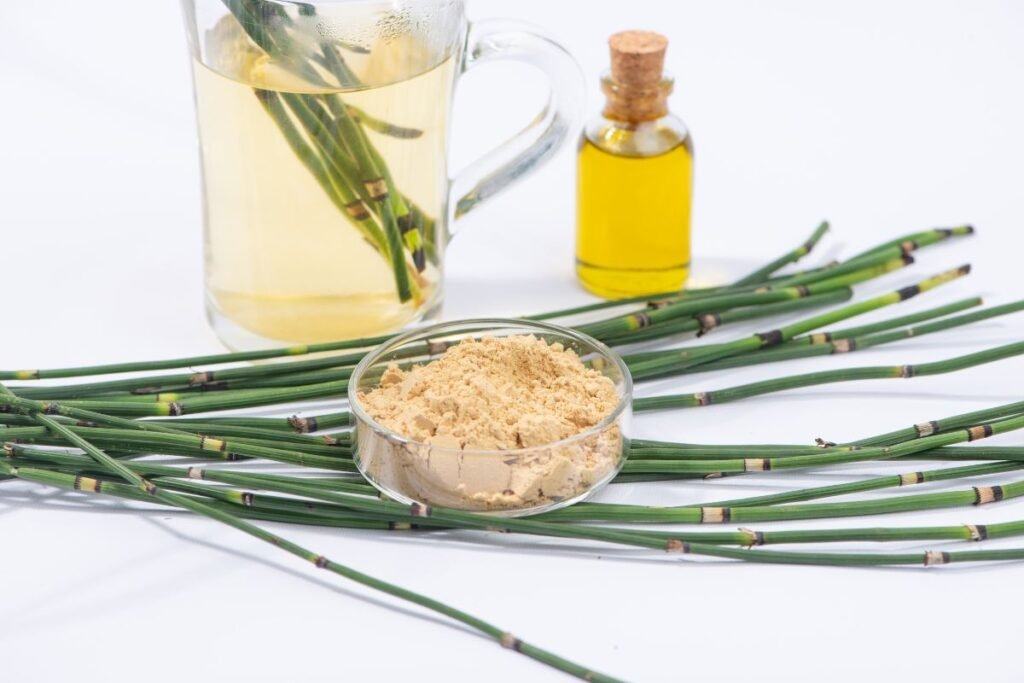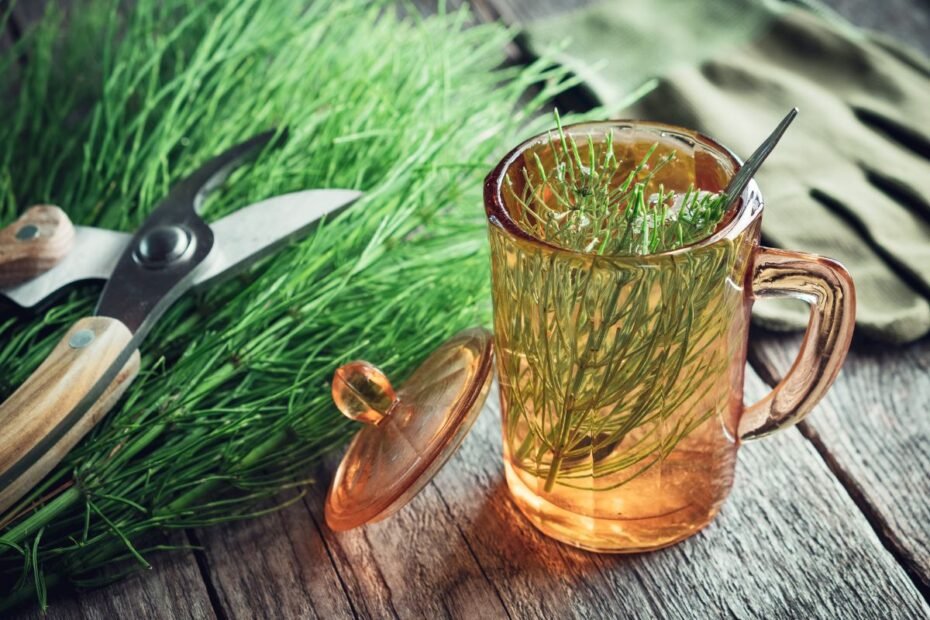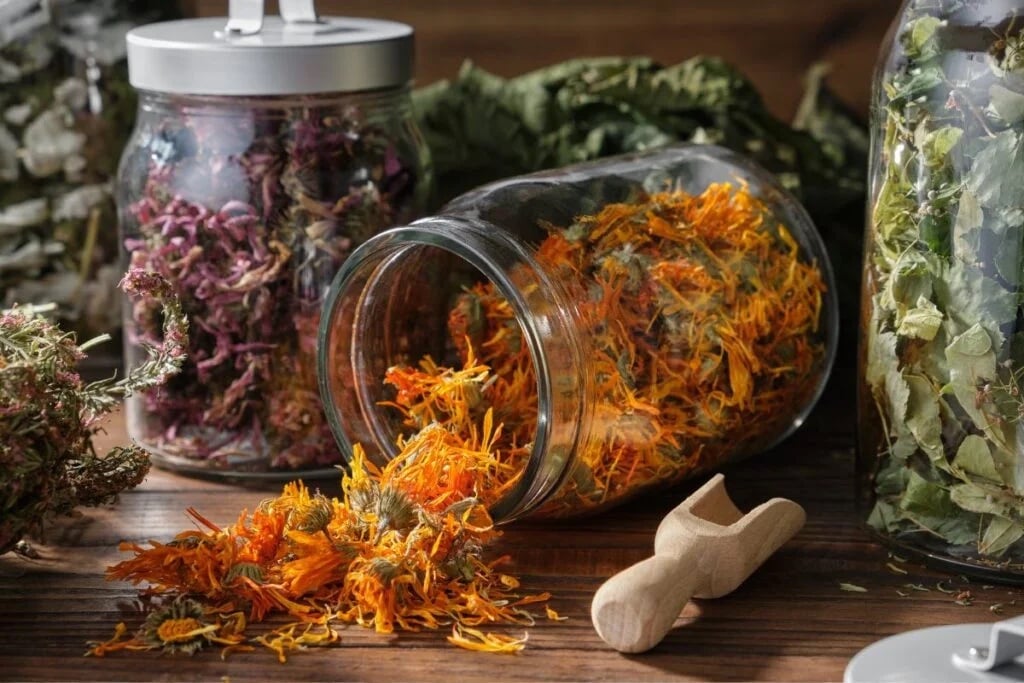The horsetail is one of the most common plants and is usually considered a weed. It is also a remarkably vigorous grass that is difficult to eradicate. However, the whole plant does not deserve your anger. This plant is highly rich in beneficial properties that can strengthen the body and cure many ailments. Horsetail tea has been used in folk medicine for centuries because they know the horsetail tea benefits.
What Kind of Plant is It?
This plant is old and abundant. It has different names in folklore. If you hear people talking about the equisetum, marestail, puzzlegrass, snake grass, candock, or scouring rush, you should know they are probably talking about the horsetail plant. The literal translation of the Latin name Equisetum (Equus + seta) means ‘horse bristle.’
Horsetail belongs to a family of prehistoric plants that have existed since 230 million years ago. There are more than 30 plant species of the Equisetaceae family. They are distributed almost worldwide, except in Antarctica, New Zealand, and Australia.
You can recognize a horsetail easily by its hollow, narrow, reed-like, or bamboo-like stems. This is the main characteristic that links all species of horseshoe crabs. Other features vary slightly from species to species.
Horsetails prefer moist, acidic, sandy, and gravelly soils. The plants like full sun. They grow from spring to autumn. Snake plants do not flower or produce seeds. They reproduce through spores, which are brownish color stems that grow in early spring dispersed spores. After spring stems disperse the spores, they die and instead of them grow summer green stems. The vegetative stems of the horsetail die back at the first frost. The well-developed, deep root system, where the plant stores energy, makes marestail a hardy plant.

Field Horsetail
The most widely discussed and commonly used for medicinal purposes is the field horsetail, or another name is common horsetail (Equisetum arvense L.).
The vegetative (summer) field horsetail stems are green thorn-like branches growing around the stem in stages. In appearance, the plant resembles a small spruce tree. It is a widespread plant, mainly found in open natural areas such as meadows, fields, etc. It also grows in gardens and allotments, especially if the soil conditions are acidic and moist.
The Medicinal Raw Material of Horsetail
You can prepare the medicinal raw from the whole above-ground part of the horsetail plant. Harvest it throughout the summer, from June to September. Cut the upper part of the stonecrop, leaving about 5 cm of stalk. You should collect the medicinal raw material on a clear, dry day.
Dry the herb at no more than 45 °C in a well-ventilated place protected from direct sunlight.
When properly dried, the grass is light green and has a non-intense, sour smell and taste. Store the dried medicinal raw material in an airtight container in a dark place. It retains its beneficial properties for up to four years.

Important Things to Know About Assuming Horsetail Tea
Only dried herbs you can use to make medicinal horsetail tea, decoctions, tinctures, infusions, etc.
Fresh horsetail can have toxic effects.
Do not harvest the spring (fruiting) field horsetail stems for medicinal use.
Rough Horsetail
Rough horsetail (Equisetum hyemale) is another species of horsetail naturally occurring in many areas. They prefer poor soils, such as sandy and gravelly soils, and keep company with plants such as heather, pine, etc.
The rough horsetail has a branched stem with a cone at the tip. It differs from the groundsel in that it has no branches.
This species is also cultivated for ornamental purposes as a garden ornament, especially near water bodies. The hollow, reed-like stem is used to make ornamental bundles or compositions of dried stems.
Rough horsetail is a natural abrasive. It is called rough for a reason. It is used for scrubbing pots and polishing wood, bone, or metal.
As a medicinal raw material, coarse horsehair is used less frequently. However, it also has beneficial properties, like its urinary excretory properties.
The collection and preparation of the medicinal raw material of the rough horsetail are the same as those of the ground horsetail.

How Rich is The Horsetail?
Horsetail is rich in active substances beneficial for the body’s overall health. It contains flavonoids, alkaloids, tannic and bitter substances, minerals, resins, and vitamin C. The main health benefits of horsetail are due to its antioxidants and silicic acid, which are more abundant in fenugreek than in any other plant.
Horsetail Tea Benefits
In general, horsetail is beneficial for boosting immunity, cleansing toxins from the body, and improving metabolism. It also has healing effects on specific areas of the body.
- It helps treat osteoporosis and promotes bone health. The silica in the horsetail stimulates the regeneration of bone tissue, increases its density, and inhibits the development of brittle bones.
- It acts as a natural diuretic. This effect is one of the most important reasons why it is valued in folk medicine.
- Horsetail tea can be used to alleviate symptoms of incontinence and the sudden urge to urinate.
- It is effective in treating skin diseases and disinfecting wounds.

Horsetail Tea: How to Prepare and Consume It?
Horsetail tea is a beverage most commonly used for health or therapeutic purposes. You can prepare dry, raw horsetail plant material yourself or buy it from specialized outlets. In pharmacies, medicinal preparations of horsetail are also available in capsule or tincture form.
To prepare horsetail tea, follow these steps:
Take 2-3 teaspoons of dried horsetail herb and boil 200 ml of water. Cover and soak for 5–10 minutes. After that, strain the tea and drink. It is recommended to prepare fresh tea for each cup.
Drink 1-2 cups of tea per day, preferably after meals. Avoid drinking this tea in the evening. This tea should also not be consumed for more than 1 week, as the diuretic effect may result in excessive mineral excretion.

Decoction of Horsetail for External Use
The toxin-removing and antiseptic properties of the decoction make it suitable for external use as a therapeutic bath, poultice, and gargle.
To prepare the decoction, you will need the following:
- 4 tablespoons of dried horsetail herb,
- 400 ml of water.
Place the raw material of the horsetail in a saucepan and cover it with 200 ml of boiling water. Simmer for another 30 minutes, turn off the heat, and leave to stand for another 10 minutes. Then strain the decoction and add another 200 ml of boiled, warm water. You can drink this decoction half a glass, three times a day, after meals.
Use this decoction externally.
- For washing and disinfecting hard-to-heal, wet wounds.
- To treat skin diseases such as eczema.
- Poultices to relieve joint pain.
- Detoxifying baths.
Prepare a seated bath if you have urinary tract infections afflicted. Place 3 handfuls of dried horsetail herb in hot water, wait 10 minutes, and sit in the prepared bath until the water has cooled down completely.

Horsetail Helps Heal Postpartum Wounds
Medical studies have shown that episiotomy (perineal incision) preparations with the herb horsetail help women who have undergone episiotomy during childbirth. The 108 women who gave birth in the study used an ointment with horsetail extract twice a day for 10 days. This accelerated wound healing and reduced pain.
You can expect similar effects from poultices and washes made with a decoction of horsetail. However, there are no clinical trials to confirm this yet.
Horsetail: First Aid for Hair Loss
Studies show that horsetail tea benefits include hair health due to its silicon and antioxidant content. In particular, it can help prevent hair loss and stimulate hair growth.
In a 3-month study, women took two capsules of dried horsetail herb daily. The results were unequivocal: it strengthened the hair and stimulated hair growth.
Other studies in which the subjects used preparations with horsetail also showed very similar results.
So, if you have a problem with hair loss, you can try horsetail tea as a preventive measure, but at short intervals.

Side Effects of Horsetail Tea
Take horsetail preparations, including tea, for up to a week. After that, a break is necessary. Also, do not drink more than 2 cups per day.
Avoid drinking horsetail tea if you:
- You are taking antiretroviral drugs for the treatment of HIV.
- You have severe kidney disease.
- If you are allergic to nicotine (the plant contains this substance).
- If you have a deficiency of vitamin B1 (thiamine) (especially for alcohol abusers),.
- You have diabetes (horsetail can cause hypoglycemia).
- You have a potassium deficiency (it can eliminate too much potassium from the body).
- If you are allergic to carrots.
- You are pregnant or nursing.
Sources:
- https://www.healthline.com/nutrition/horsetail
- https://www.verywellhealth.com/horsetail-4692253
- https://smallgrains.wsu.edu/weed-resources/common-weed-list/horsetail/
- https://www.tuasaude.com/en/horsetail-tea/#google_vignette
Associative photos from © Canva.

